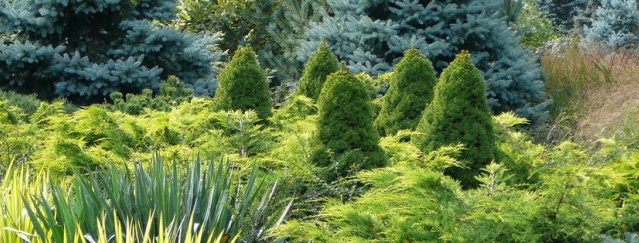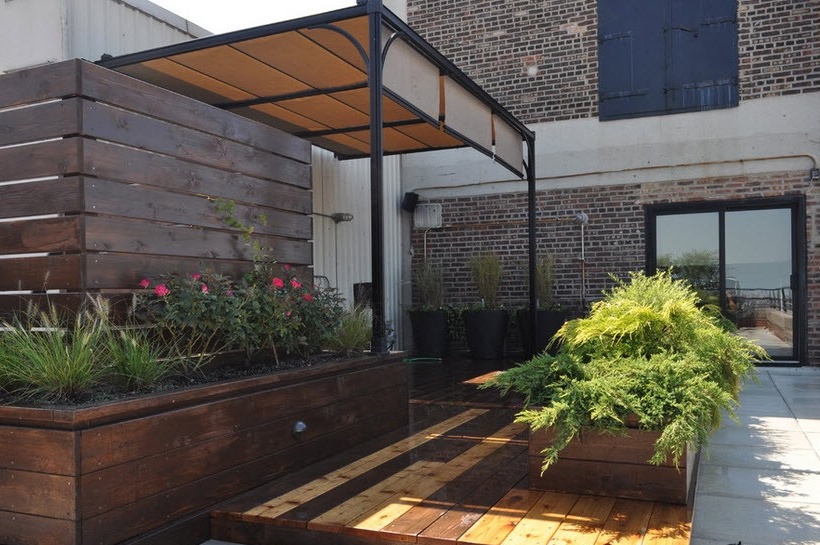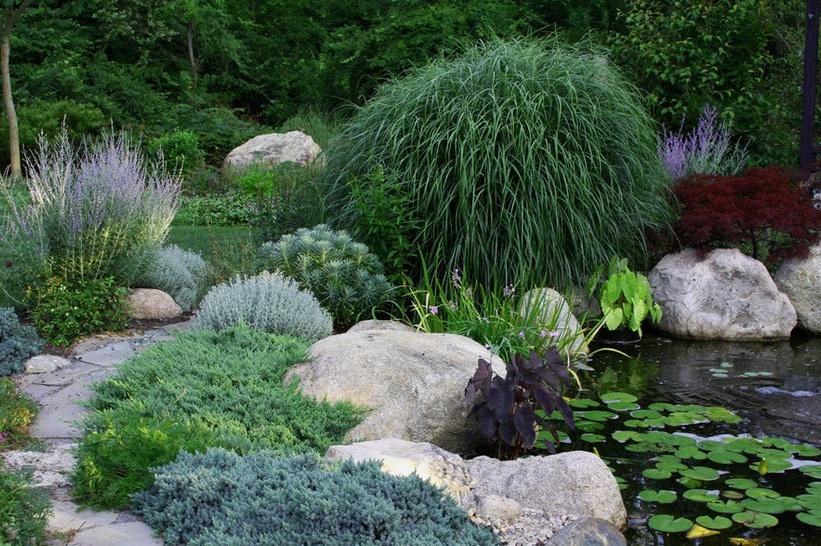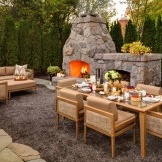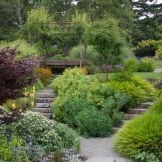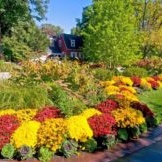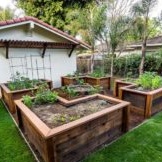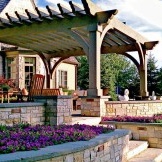Juniper in landscape design - the king of landscape art
Juniper is a very beautiful plant belonging to the oldest family of cypress trees, appearing on the earth fifty million years ago. Starting from the mountain tropics and ending with the polar zone, about 70 varieties of this plant grow. For the most part, juniper with small areas is located on the mountain plains. The inhabitants of the mountain slopes and rocks are low-growing and creeping species of this plant. Juniper can sometimes reach a height of 15 meters mainly in the arid territory of Central Asia, as well as America and Europe - this is a tree-like juniper. Let us dwell on the species in more detail.
Varieties of juniper used for landscape design
Common juniper, which is a tall, sprawling shrub with needles, which has a slightly bluish tint. Its needles are very prickly and have a needle-shaped shape. If we consider this species for landscaping a suburban area, garden forms, such as dwarf and columnar shrubs, are usually grown. By the way, to create alpine slides the most suitable are dwarf,
but to create hedges - columnar junipers. However, for group or single landings, they are also suitable. The most common forms of this species are Compressa, Green Carpet, Sentinel and Repanda.
Juniper Cossack has scaly needles and is one of the most undemanding species. Typically, an adult plant reaches a height of one and a half meters, while its lower branches can be needle-shaped. Most often used for planting in rockeries or on lawns. Used on rocky slopes for covering the soil. And its most common forms are Variegata, Tamariscifolia and Glauca ,.
Chinese juniper is a tree plant, the height of which can reach 8 - 10 meters with needle-shaped or scaly needles, having a golden yellow color or a different shade of green.
Most often used for group plantings or rock gardens. The most common varieties include Stricta, Olympia, and Blue Alps.
Horizontal juniper is a creeping low shrub with branches pressed to the ground and short needle-shaped or scaly needles, the color of which may be different - it depends on the variety. The needles can have green, gray-green, blue or silver-blue shades.
The best option for using this plant is for decoration of decorative borders, slopes or for the design of rocky terrain.
Juniper sweetie is a very miniature shrub no more than half a meter high with very beautiful silver-blue needles, refers to the creeping plant species, covering an area of no more than 3 square meters. An ideal plant for creating alpine slides.
Let's talk about the characteristics of planting juniper
The fact is that any kind of juniper (especially Cossack) needs special conditions in the process of planting. First of all, you should always remember that this plant is planted exclusively in sunny areas, otherwise it will simply lose its decorative properties. An exception to the rule is only common juniper. In landscape design, it is important to consider that between these plants there should be a distance of at least half a meter (this is if the juniper is small) and one and a half to two meters for large plant species. Otherwise, subsequently there will be no distance between them, moreover, they will begin to obscure each other.Another important point - do not plant them next to stunted plants, which will lack neither light nor nutrition. The best option is to plant juniper around the perimeter of the house, as well as in front of the house.
Thus, you get a kind of original hedge. Sometimes the plant is staggered throughout the site or, for example, near the rock garden. Then the pots with young plants are placed in the order in which they are planted. Container plants must necessarily be well saturated with moisture, for which they are kept for two hours in a container of water. Next, a pit is prepared, which should be slightly larger than the pot itself. Before planting the plants, it is recommended to dig the area to the depth of the shovel, clean off any debris and fertilize. A drainage layer is made at the bottom of the pit, for example, of sand or broken brick. The layer should have a thickness of 15 to 20 cm. Then the roots of the plants are covered with a soil mixture of turf, sand and peat, while peat should make up two parts of the mixture, and the remaining components, one at a time. If the plants are large, the root neck at the time of planting should be slightly higher than the edges of the soil surface.
The use of juniper in landscape design
Since this plant is unusually beautiful, it is widely used for landscaping garden plots. Tree varieties, for example, are used in group or single variants of parkland. With the help of these plants you can create a wonderful hedge. Low-growing species, as well as dwarf species, are most used in rock gardens and rockeries, i.e. in rocky gardens.
It is possible that the juniper planted in order to prevent erosion, because it holds soil well. In the background, as a rule, tall columnar varieties are planted, having green or blue needles, imitating blue distances,
It should be remembered that the plant categorically does not withstand gas contamination, because “Loves” only ecologically clean zones. Therefore, for landscape design of a metropolis, the use of this plant is excluded.
In what styles of landscape design is juniper appropriate
Despite all the beauty of an evergreen plant, its harmonious presence is appropriate only for certain styles of landscape design. For example, juniper will be perfectly combined with the Scandinavian style, which is characterized by clear geometric shapes, as well as spaciousness and naturalness. Juniper, which has bright colored needles and is located on the background of moss, lichen and heather, will look extremely profitable and spectacular, acting as an expressive accent of the composition.
If the site is decorated in the English style, then it is simply inconceivable without juniper. However, if dwarf varieties are most suitable for the Scandinavian style, then in this case its larger species, having calmer shades (green or blue), are appropriate. Those. the plant should not be an accent in this restrained style, but should serve as the final element to give the composition a finished look.
Juniper is also appropriate in styles such as Japanese and Oriental. Amid a riot of colors, the natural simplicity of this plant will carry a shading function. For this, designers recommend planting juniper next to heathers of bright colors.
The neighborhood of juniper with other plants
To begin with, juniper is a magnificent plant, but in itself it is not as interesting as in combination with other representatives of the plant world. However, not all plants withstand this neighborhood.
For example, pampered rosesand also peonies and clematis should be planted at a distance from conifersequal to at least two meters. Moreover, the gaps between the conifers, it is advisable to mulch and close or use a dump with the help of decorative chips.
Ground coverers, for example, from evergreen plants such as thyme, bryozoans, tenacious, saxifrage, etc., are good for sodding. Thus, they will create a background and at the same time protect against the appearance of weeds. Mulch and dumping perform the same functions. For mulching, peat, walnut husk, coniferous litter, crushed bark, etc. are suitable.
If the juniper is planted in a permanent place, do not place it at close range - the landscape will be monotonous. If the site is rocky, then it is very beneficial to shade the simplicity of plants using barberries or dwarf heathers. On a sunny lawn, especially if there is a stream or flower garden nearby, yellow and orange spireas are perfect companions for juniper. When making the entrance, as well as the front lawn, juniper is best combined with other conifers. If a stone is used in the composition (granite chips or natural boulders), it looks more original and charismatic.
In winter, juniper, like any other coniferous plant, is the real king of the whole landscape, playing the most important role (of course, if it does not need shelter). Most importantly, remember that juniper categorically will not be combined with lush crops and flowers with large inflorescences - this should be taken into account when creating landscape design. Of course, if you approach this issue skillfully, you can achieve unity and in this case, for example, using a stone with which to create transitions between these different plants. And you can apply glades planted with creeping plants. This is a well-known technique for creating alpine slides.
From the foregoing it follows ...
Summarizing the above, it can be noted that planting juniper in the garden can solve several problems:
- the creation of color accents (spots);
- creating a favorable background for flowering plants;
- slope strengthening;
- hedge building
- growing a medicinal plant (juniper cones are widely used in folk medicine)

